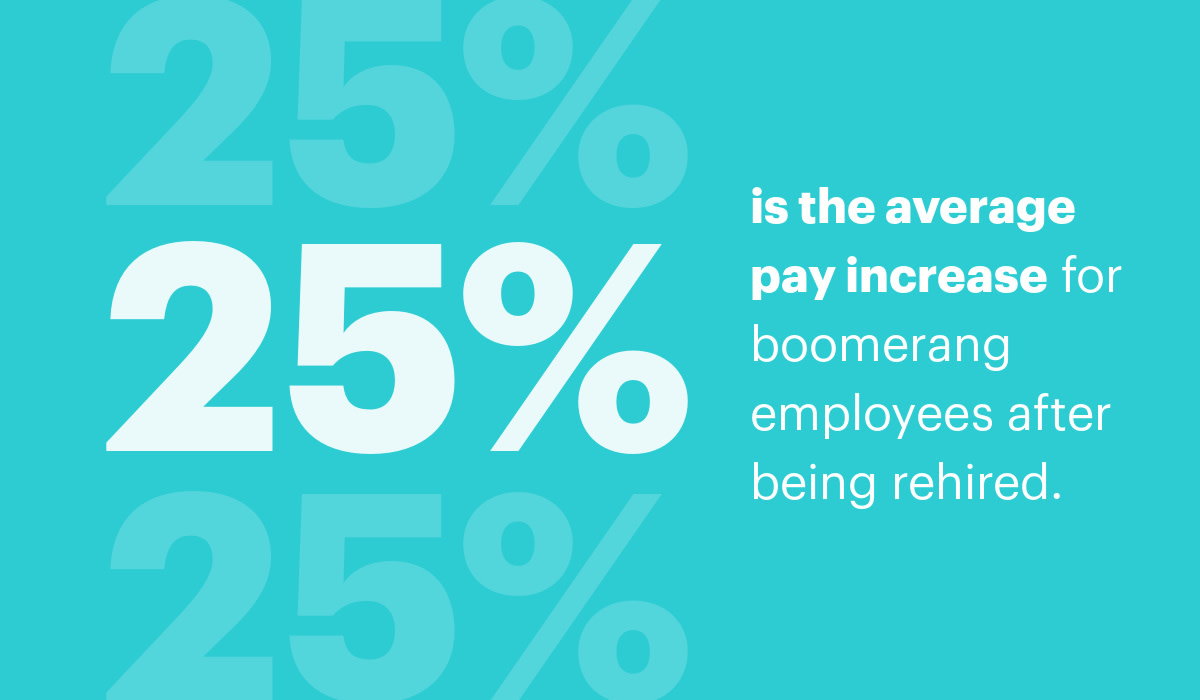Boomerang Employees Return to Work—On Their Own Terms
New research finds that boomerang employees are returning to previous employers—but this time with higher pay and better titles.

We’re well past the days when employees stayed with a single employer for their entire career. According to the Bureau of Labor Statistics, the median number of years that wage and salary workers had been with their current employers was 4.1 years in January 2020.
However, while employees may be quitting their jobs at a record rate, according to Visier’s new report, Boomerang Employees Make a Comeback, a lot of those leaving may also be returning. In fact, these so-called “boomerang employees”—employees who leave their employers and return later—made up over a third of external hires in 2021. And while this could be a lucrative talent acquisition strategy for organizations, we also found that boomerang employees are returning on their own terms, which includes higher titles and a significant pay raise. Which makes you wonder: how could these employees have been retained in the first place?

Download Visier’s new report, Boomerang Employees Make a Comeback, to learn more about this rising trend.
The Great Resignation inspires employees to search for better work
33 million Americans quit their jobs during the Great Resignation, an alarming number that has sent companies scrambling to fill vacant positions, and from a shallow talent pool. In Visier’s survey, they found that most boomerang employees left their companies due to a lack of either real or perceived advancement opportunities, burnout, or for health reasons. They may feel that opportunities for growth or learning are limited. They may feel their salary is unfair. Or perhaps they had a desire to work in a different industry. It could even be that they left because they were tired of the long commute to the office (if this is the reason, you might be able to offer a satisfactory WFH plan).
Others had even more personal reasons for leaving. Employees are increasingly looking for leadership roles, increased scope, and responsibilities that can help them have a greater impact. They are also looking for companies who are mission-driven and whose values are closely aligned with their own. Women, especially, find themselves bumping up against the glass ceiling. Rising inflation, currently at 9.1% in the U.S. is another contributing factor, a driver to search for higher pay. No matter what their original reason for leaving, it may be a temporary thing. For example, burnout can be cured by a long sabbatical, after which an employee feels ready to return to work. Similarly, health concerns may also wane. But one thing is certain from our research: boomerang employees would not have had the same opportunities had they stuck with the company.
While quitting in order to find a better job is nothing new, the pandemic now finds job seekers looking at the market in a whole new light. Yes, many workers have unplugged, moved to Bali, or are living off their investment portfolio (good luck with that). But the pandemic has given people more time for self-reflection and to reevaluate their career trajectory. Workers are now more open to going back to a former employer and HR is responding.
High performers among boomerang employees
It’s not just that a large number of people are quitting, it’s who is leaving: our research shows a quarter of boomerang employees were high performers. So not only are companies losing the profits of high performers in the first place, but they’re wasting additional effort and resources on rehiring them, and at a higher cost—boomerang employees earned an average of 25% higher pay than before they left. And it’s not just their salaries that are getting a bump, 40% of rehired managers used to be individual contributors at time of resignation. This puts boomerang employees in a position of strength when renegotiating with a former employer. Not only can they prove that they are (and will continue to be) a high performer, they may be able to show that they’ve picked up additional skills at another company that can be hugely beneficial to the company they are returning to. Our data suggests that today’s boomerang employees typically return to their previous employers after around one year away, and come ready to renegotiate their salaries, titles, and other job perks.

Boomerang employees earn an average of 25% more than before they left.
Rehiring as a recruiting strategy
Hiring back employees that left can be an effective hiring practice that can lower hiring costs, speed onboarding, and provide you with an outside perspective. Rehires return to the jobs they left with more skills, more confidence, and more of a sense of agency than at almost any time in recent history. HR departments can take advantage of this by mining their existing alumni networks, encouraging workers to reach out to their former colleagues (perhaps by offering a bounty) and can work to make the rehire process a less stressful and smoother experience than starting from scratch. At a time when many people are rethinking their careers, rehiring makes more sense than ever.
Boomerang employees have several advantages over other potential hires. They know your company, its processes, tools, and culture. They may be returning to the same or a similar role that they held previously so they have already been trained. In addition, they may have picked up additional skills at a competitor or other company in your field.
Rehiring is a trend you should get behind. Our data shows that the practice, while still relatively new, is growing. 29% of newly hired employees—both full and part-time permanent positions—were rehires in 2020, compared to 27% in 2021 and 28% in the first four months of 2022.

Boomerang employees made up over a third of external hires in 2021.
Lay the foundation before employees leave
Visier found that, for companies who think they may be in a position to rehire employees, the exit interview was an effective way to make sure the employee leaves your organization on good terms. In the exit interview, you can ask questions about why they’ve decided to leave and better understand their motivations. In the interview, you can make sure to get their personal contact information so you’ll be able to find them again, once they no longer have a company email address. If they are someone you definitely want to keep your eyes on, ask for their social profiles as well. The exit interview is a good time to tidy up any loose ends. Some companies, notably LinkedIn, have strong alumni networks and regularly host alumni days where former employees can reconnect with lost colleagues, return to campus, and be reminded of what a great company you have.
Our research shows that the prime time to reach out to your alumni network is within the first 12 months after an employee leaves. In nearly every case of an employee being rehired, they were contacted by someone from HR or from a former colleague to let them know of an open position. You should involve your employees in the hiring process by encouraging them to develop social networking skills themselves. That way, they can be a resource by reaching out to their former colleagues.
We also found that, in many cases, the reasons people return are much the same as why they left your company in the first place. The grass isn’t always greener when they get to the other company. Some boomerang employees found that the new role didn’t match up with their expectations, or they didn’t like the company culture or their co-workers. Perhaps the onboarding process was lacking and they found themselves floundering or there was a lack of work/life balance. Because boomerang employees have a tendency to maintain relationships with their previous managers, co-workers, or mentors, they welcome the return to a familiar culture.
Better yet, keep employees before they go
Understanding who is leaving, why they are leaving, and who might be in a position to return, is the new challenge for HR. Good and timely data is the key to predicting who is likely to leave. While attrition is nothing new, it’s harder than ever though to predict if and when a particular employee might leave, or to know what it would take to bring them back. Knowing which factors are playing the biggest role in this attrition is critical to stemming the tide, and people analytics can help uncover what motivates your people, see who is most at risk of leaving, and reduce turnover. Whatever you do, don’t wait too long. Our data shows that you have about a year to rehire an employee before they become much less available.
If the Great Resignation has taught us anything, it’s that we need to start listening to our employees, and especially closely to such things as perceived engagement, inclusion, and growth opportunities. Those higher salaries certainly help, but employees are more keen than ever of the other employment opportunities out there. Keeping a pulse on employees who have left the company for good versus those that returned can help with both your talent acquisition and retention strategies.
On the Outsmart blog, we write about workforce-related topics like what makes a good manager, how to reduce employee turnover, and employee burnout. We also report on trending topics like the Great Resignation and preparing for a recession, and advise on HR best practices like how to present headcount data to your CEO, metrics every CHRO should track, and connecting people data to business data. But if you really want to know the bread and butter of Visier, read our post about the benefits of people analytics.


